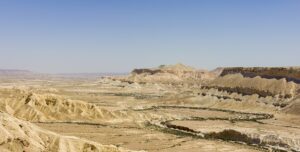
Ein Avdat, Negev. By Andrew Shiva / Wikipedia, CC BY-SA 4.0, https://commons.wikimedia.org/w/index.php?curid=28865649
Three sites in the Bible—and perhaps four—are called Aroer (pronounced Ah-roe-air). We call one Aroer of the Negev. The other two—or three—are east of the Jordan River.
Aroer may mean “crest of a mountain.” This very general description would explain why several sites have this name. Or, Aroer may be derived from the name of the juniper plant, Ar’ar(Juniperus Phoenicia), a common plant in arid zones; this meaning also could give rise to several Aroers.
The most frequently mentioned Aroer is on the bank of the river known in the Bible as the Arnon (the Wadi Mujib). The Arnon was on the ancient route called the King’s Highway on the high plateau east of the Jordan River. This Aroer marked the southern boundary of the Israelite territories in Transjordan and is even mentioned in line 26 of the famous Mesha stone. A Spanish archaeological team excavated this Aroer in 1964–65.
The second Biblical Aroer is located near ancient Amman, located at modern Amman, capital of Jordan. This Aroer was part of the territory of the tribe of Gad. Jephthah, one of the Israelite judges, fought the Ammonites “from Aroer to Minnith” (Judges 11:33). The exact identification of this Aroer is, however, uncertain, and it has never been excavated.
Read the rest of “And David Sent Spoils … to the Elders in Aroer” (1 Samuel 30-26–28) in the online Biblical Archaeology Society Library.